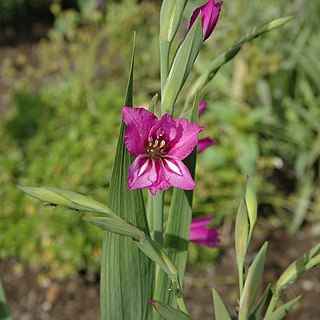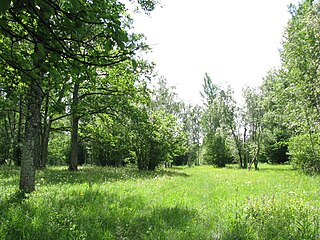
A nature reserve is a protected area of importance for flora, fauna, funga, or features of geological or other special interest, which is reserved and managed for purposes of conservation and to provide special opportunities for study or research. They may be designated by government institutions in some countries, or by private landowners, such as charities and research institutions. Nature reserves fall into different IUCN categories depending on the level of protection afforded by local laws. Normally it is more strictly protected than a nature park. Various jurisdictions may use other terminology, such as ecological protection area or private protected area in legislation and in official titles of the reserves.

An alvar is a biological environment based on a limestone plain with thin or no soil and, as a result, sparse grassland vegetation. Often flooded in the spring, and affected by drought in midsummer, alvars support a distinctive group of prairie-like plants. Most alvars occur either in northern Europe or around the Great Lakes in North America. This stressed habitat supports a community of rare plants and animals, including species more commonly found on prairie grasslands. Lichen and mosses are common species. Trees and bushes are absent or severely stunted.

Soomaa National Park is a national park in south-western Estonia. Soomaa protects 390 km2, the park was created in 1993. Soomaa has been an Important Bird Area since 1989, a Ramsar site of protected wetlands since 1997, and a Natura 2000 area since 2004.
The Central Balkan National Park is a national park in the heart of Bulgaria, nestled in the central and higher portions of the Balkan Mountains. Its altitude varies from 550 metres (1,800 ft) near the town of Karlovo to 2,376 metres (7,795 ft) at Botev Peak, the highest summit in the range. It was established on 31 October 1991.
Matsalu National Park is a nature reserve and national park situated in the Lääne and Pärnu counties of Estonia. Matsalu National Park spans an area of 486.1 km2 (187.7 sq mi), comprising Matsalu Bay, the Kasari River delta, the village of Matsalu and surrounding areas.
Kaljo Pork was an Estonian botanist. He was affiliated with the Estonian Institute of Zoology and Botany between 1952 and his death in 1981.

Alam-Pedja Nature Reserve is the largest nature reserve in Estonia. It is a vast wilderness area which covers 342 km2 and consists of a complex of 5 large bogs separated by unregulated rivers, their floodplains, and extensive forests. The nature reserve aims to protect diverse ecosystems and rare species, mainly through preserving the natural development of forests and bogs and securing the continuing management of semi-natural floodplain grasslands.

Scratchwood is an extensive, mainly wooded, country park in Mill Hill in the London Borough of Barnet. The 57-hectare site is a Site of Metropolitan Importance for Nature Conservation and together with the neighbouring Moat Mount Open Space. It is a Local Nature Reserve.

Luitemaa Nature Reserve is a nature reserve situated in south-western Estonia, in Pärnu County.

Viidumäe Nature Reserve is a nature reserve situated on Saaremaa in western Estonia, in Saare County.

Agusalu Nature Reserve is a nature reserve situated in eastern Estonia, in Ida-Viru County.

Lindi Nature Reserve is a nature reserve situated in south-western Estonia, in Pärnu County.

Nedrema Nature Reserve is a nature reserve situated in south-western Estonia, in Pärnu County.
Laidevahe Nature Reserve is a nature reserve situated on Saaremaa in western Estonia, in Saare County.

Roding Valley Meadows is an 18.9-hectare (47-acre) biological Site of Special Scientific Interest in Buckhurst Hill in Essex. It is part of a 65.2 hectare Local Nature Reserve with the same name, which is owned by Epping Forest District Council and Grange Farm Trust, and managed by the Essex Wildlife Trust.

Wooded meadows are ecosystems in temperate forest regions. They are sparse natural stands with a regularly mowed herbaceous layer.
Vahenurme Nature Reserve is a nature reserve situated in western Estonia, in Pärnu County.

Keeri-Karijärve Nature Reserve is a nature reserve situated in south-eastern Estonia, in Tartu County.
Kõrgessaare Nature Reserve is a nature reserve situated on Hiiumaa island in western Estonia, in Hiiu County.
The West Estonian Archipelago Biosphere Reserve is a UNESCO Biosphere Reserve in Estonia, located in the West Estonian archipelago in the eastern Baltic Sea. The 15,600 square kilometres (6,000 sq mi) reserve comprises the islands of Saaremaa, Hiiumaa, Vormsi and Muhu, as well as numerous islets and marine parts. The islands are in the transition zone between temperate needle-leaf and broadleaf forest.



















